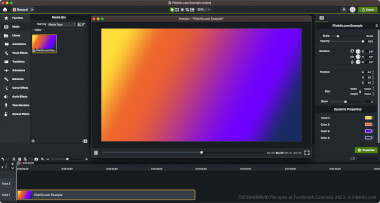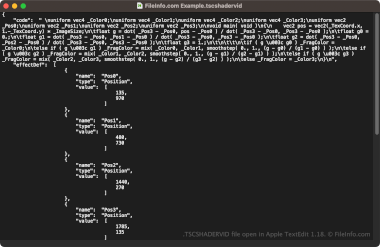.TSCSHADERVID File Extension
Camtasia Dynamic Background
| Developer | TechSmith |
| Popularity |
2.0 | 1 Vote |
What is a TSCSHADERVID file?
A TSCSHADERVID file contains a dynamic background used by TechSmith Camtasia, a screen recording and video editing application. It stores plain text settings that make up the appearance and movement of the background that Camtasia users add to videos to enhance them. Users primarily open TSCSHADERVID files in Camtasia but may also open them with a text editor to view their contents.
More Information
TechSmith introduced dynamic backgrounds and the TSCSHADERVID file type when it released Camtasia 2023. The software comes packaged with various styles of backgrounds, including rings, stars, sunbursts, triangles, neon ripples, and radial lights.
How to access dynamic backgrounds in Camtasia
You can access the dynamic backgrounds in Camtasia by selecting "Library" in the pane on the left side of the program interface, then opening the "Dynamic Backgrounds" folder. You can then drag and drop the dynamic background onto your video.
Camtasia also lets you export your dynamic background in a .LIBZIP file to share the asset with other Camtasia 2023 and later users. To export the asset, which includes the TSCSHADERVID file, an .ASSETPROJ file, and other resources, right-click the dynamic background and select Export Asset.
How to open a TSCSHADERVID file
You can open TSCSHADERVID files with TechSmith Camtasia in Windows and macOS. To open and add TSCDF files in Camtasia, you can simply double-click the file, and Camtasia will add it to the "Media Bin" (located within "Media" in the pane on the left side of the program interface. You can also drag and drop the TSCSHADERVID file into an opened Camtasia video project.
Additionally, if you are opening a dynamic background exported as an asset in a LIBZIP file, you can select File → Import → Zipped Project.
Opening a TSCSHADERVID file with a text editor
Since TSCSHADERVID files are saved in plain text, you can also open them with a text editor, such as Microsoft Notepad (Windows) or Apple TextEdit (macOS), or a source code editor. You may need to rename the .tscshadervid file extension to .txt for the text editor to recognize it.
When opened in a text editor or source code editor, you can modify the properties of the TSCSHADERVID file. However, if you incorrectly edit the file, you may inadvertently break the dynamic background.

